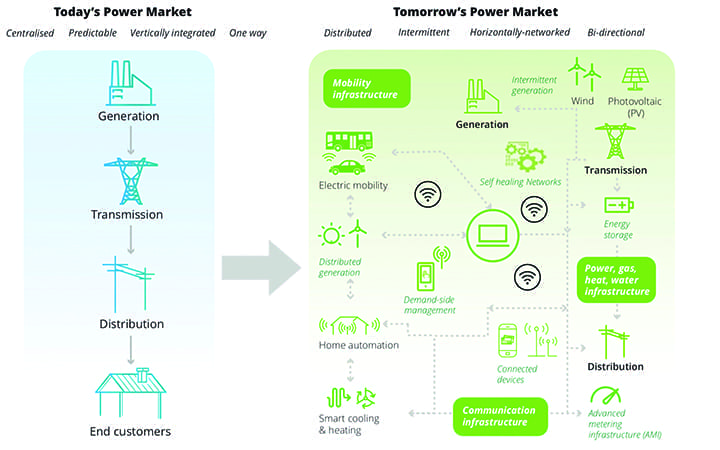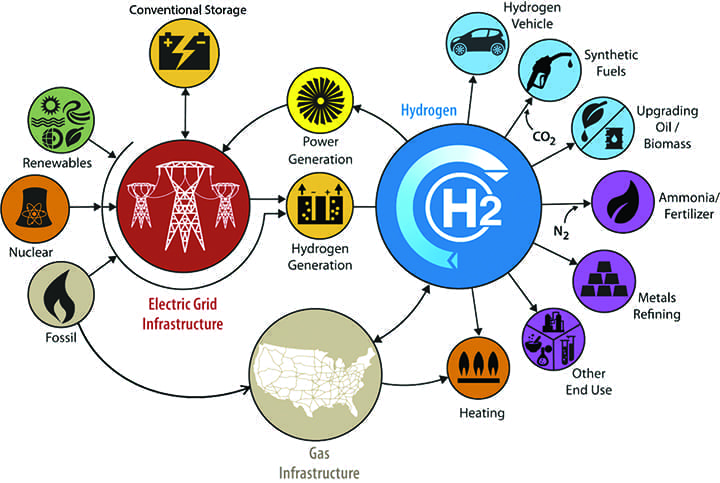The Evolution of Power Business Models
The post The Evolution of Power Business Models appeared first on POWER Magazine.

Traditional models have been upended by recent disruptions, including decarbonization, decentralization, and even the COVID pandemic, but new ones are replacing them that focus on customer preference, regulatory, and market structure transformations. Experts explain how we got here, and where we may be heading.
Every evolutionary story has a point of origin, and for the modern electric utility industry, that point began with invention of the practical lightbulb in 1878 by Thomas Edison. To spur demand for the novel invention, Edison eventually developed an entire power system that generated and distributed electricity. But while the concept caught on in several cities in the early years, owing to exorbitant costs, power companies rarely owned several power plants.
Samuel Insull, who began his role as president at Chicago Edison in 1892, is credited with first exploiting load factor, not only finding power customers for off-peak times, but leveraging technology including larger generation systems and alternating current to produce and transmit power more cheaply. Crucially, he is also said to have pioneered consolidation; he acquired 20 small utilities by 1907 to give birth to a natural monopoly-Commonwealth Edison.
The model was widely emulated, and for decades, scale economies associated with large centralized generation technologies encouraged vertical integration to drive down power costs, encourage universal access, and provide reliability. To enforce the responsibilities and rights of these investor-owned utilities (IOUs) and their customers, however, this approach also spurred more government oversight and regulation. It also gave rise to both municipal ownership, and later, as a New Deal measure, public power to enable rural electrification.
A Crucible of ChangeAccording to John Shenot, a senior advisor at the Regulatory Assistance Project (RAP) who advises state utility commissions and environmental regulatory agencies on public policy best practices, business models began to shift more distinctively starting in the late 1970s, as environmental policy, the oil shocks, and initiatives to open the airline and trucking industries to competition disrupted the status quo. The evolution that's happened in the last 40 years falls into two big buckets: the introduction of competition-that's where the most change has happened; and reforming the way monopoly utilities operate," said Shenot.
Competitive models were rooted in the recognition by policymakers that with the right policies in place, first you can introduce competition in the generation of electricity, for the large industrial plants, and others that had the technical capability, the finances, and the desire to generate their own electricity," he said. Policymakers, meanwhile, recognized that opportunities for competition could be broader: [They thought] what we could do is essentially make transmission and distribution the highway system, and say that anybody who wants to get into the generation business has the right to do that-the utilities can't keep them out of that business. And this led to a proliferation of what came to be known as the independent power producer (IPP)."
The second key step-which also led to later reforms-was passage of the Public Utilities Regulatory Policies Act (PURPA) of 1978. The law established a program implemented by states and overseen by the Federal Energy Regulatory Commission (FERC) to encourage the use of efficient cogeneration and small-scale renewables. What it did was essentially created opportunities for smaller generators to get into the game," said Shenot. But from the outset, owing to generous avoided-cost rates, the rapid growth and size of the qualifying facilities industry surprised many policymakers and entrepreneurs, and got them thinking about the viability of generation independent of regulated monopolies. In 1988, meanwhile, FERC proposed rules to allow states to set their avoided-cost rate based on an auction, effectively transforming the regulatory program into a competitive initiative.
Then, in the early 1990s, FERC also began conditioning approval in merger cases on the utility's voluntary provision of open transmission access, which began to shake up the long-held control that regulated monopolies held over ownership and operation of transmission lines. In 1996, FERC Order No. 888 established mandatory open transmission access by all transmitting utilities and a reciprocity provision successfully extended open access to non-jurisdictional entities, such as municipal, cooperative, and federal utilities. But Order No. 888's biggest impact was perhaps, the promotion of the concept of the independent system operator (ISO), an entity that would operate the transmission system independently for wholesale market participants, with an explicit aim of fostering competition for power generation.
Order No. 2000 did something similar, encouraging utilities to join regional transmission organizations (RTOs). To further their objectives, each of the ISOs and RTOs developed full-scale energy and ancillary service markets in which buyers and sellers could bid or offer generation, as well as bid-based markets to determine economic dispatch. Today, as FERC notes, two-thirds of the nation's electricity load is served in RTO and ISO regions, though major parts of the U.S. still operate under more traditional market structures, such as in the West (excluding California) and the Southeast.
The final, but just as significant, historical upheaval was energy deregulation. In the 1990s, holding competition as the most effective driver of low power costs, several states also moved to end monopoly protections for retail sales-though after California's high-profile energy crisis in 2000 and 2001, many scaled back their plans and even re-regulated their retail sectors. Deregulation had the important role of giving rise to new retail companies, whose business models were exclusively focused on delivery of power to the customer, said Shenot.
New Drivers Spur Novel ApproachesAs experts from the University of Texas at Austin's Energy Institute pointed out in a series of white papers exploring the history of the U.S. power industry, technology, financing, and regulation continue to shape business models today. As a useful reference, the Energy Institute pares down the various electric grid regulatory structures into six simplified" existing models.
Vertically Integrated (Monopoly at All Levels). This describes a single monopoly company that handles power generation and its delivery over its own transmission and distribution network. Many state-owned electric companies around the world fit this model, it notes.
Single Buyer (Limited Competitive Generation). This approach allows a single buyer, the purchasing agency, to choose from a number of different generators. Direct procurement of transmission service from competing generators to final customers is not permitted.
Wholesale Competition of Generation. This model allows load-serving entities to buy wholesale power directly from competing producers on the transmission network and deliver this electricity over a distribution network to customers. It is close to the UK system as it operated immediately after it was restructured in 1990.
Retail and Wholesale Competition. This model allows all customers to choose their electricity supplier. This is exemplified by the retail choice program in the Electric Reliability Council of Texas (ERCOT).
Vertically Integrated Municipally Owned Utilities. The municipally owned utility structure is similar to the investor-owned, fully integrated, vertical integrated model, where the residential, commercial, or industrial consumers have no choice of supplier (with the exception of self-generation).
Administrations, Authorities, and Cooperatives. In this model, generation and transmission services can be provided by Federal Power Marketing Administrations (such as the Bonneville Power Administration), agencies such as the Tennessee Valley Authority, state-created nonprofit firms (such as the Lower Colorado River Authority), or generation and transmission co-ops. These entities generate and transmit the bulk of power to rural cooperatives.
A Regulatory Upheaval on the Horizon?But according to Shenot, which, if any, of these models thrive amid the myriad disruptions facing the sector is questionable. Decarbonization, decentralization, and digitalization-as well as the recent impact from the COVID-19 pandemic-have slackened or prompted a decline in power demand. Notably, in regulatory and policy circles that concern is prompting debates about the future of monopoly utilities, he said. Discussions at state regulatory commissions have lately been focused on reforms to the cost-of-service and rate-of-return model," where regulators approve prices that are designed to recover the utility cost-of-service and make their shareholders an authorized return on their equity.
Traditional approaches have been predicated on growth, with the assumption that demand for power would grow, and utilities would be able to collect the revenues they need to pay operating expenses and service debt on capital expenditures, Shenot explained. We don't have that rapid growth anymore. Now we have these two-way flows of electricity, environmental policies, and goals we never used to have. The challenge [for regulators] now is how can we get them to operate the system efficiently, to perform in ways to help state environmental goals, ensure system reliability, and address equity issues for low-income customers?" That falls under a performance-based regulation model" and up to 15 states are now investigating or discussing it, Shenot said.
Responding to DisruptionsMeanwhile, as decarbonization, decentralization, and digitalization reshape business models, they are also spurring new ones. After decades of development of centralized systems," the move toward decentralization began in the late 2000s, with the introduction of smaller (less than 100 MW), more-efficient, and less-costly technologies that could provide electrical and mechanical power at or near the point of use, such as natural gas and diesel-powered reciprocating engines, aeroderivative gas turbines, fuel cells, solar panels, and wind turbines, that allowed generators to meet local power demand, off and on the grid (Figure 1). One often-cited early driver for the trend was the constraint that typically involved the development of large capital projects, and transmission and distribution lines. But the decentralization movement" was also powered by gas network growth, and it was accelerated by the digitalization wave, as well as a growing need for resiliency.
 |
1. Changes to the way the grid operates will create the conditions for new and different business models to emerge. Courtesy: Deloitte |
Over the past five years, as rooftop solar installations surged, falling costs for batteries also prompted their increased installation behind-the-meter, and power consumers were able to engage in demand response-which allowed them to alter their power consumption patterns and provide grid services, individually or through an aggregator. The emergence of power-generating consumers-or prosumers-as formidable new market participants, who also have more control over their consumption, has created new competition, as well as opportunities for traditional utilities.
Among notable emerging models that utilities are exploring in response to the surge of distributed and micro generation is energy-as-a-service, a delivery model that combines hardware, software, and services. As Deloitte explains, The evolving energy landscape will become vastly more complex as the cost to produce comes down, the ability to generate moves to micro levels, and products are serviced on digital platforms. End-users will look for an aggregating agent to act as a single source point for all their energy-related needs." This creates opportunities for providers who can deliver a streamlined, cost-effective solution to clients for a fixed monthly payment," it says.
Another example of an emerging model that leverages digitalization and decentralization is peer-to-peer (P2P) trading. The model is rooted in the rapid development of the sharing economy"-such as is exemplified by Airbnb and Uber-and in the power space it is being viewed as a practical solution for how intermittent small-scale generation can be integrated into a system at a low intermediary cost. It essentially involves the direct buying and selling of energy between two or more grid-connected parties through a secure platform, via a technology like blockchain.
The first recorded peer-to-peer energy trade occurred in Brooklyn, New York, in 2016, when a resident with solar panels sold a few kilowatt-hours to his neighbor via the Ethereum blockchain. A more recent example is Australian energy blockchain firm Power Ledger's collaboration with PV installer EPC Solar to allow a commercial site owner in Canberra to trade solar energy with its tenant. But though experts laud P2P for its potential to leverage the diversity of generation and demand profiles of different customers, they caution it remains challenging in practice because it can be administratively difficult to execute.
Taking Charge of the Carbon FootprintAs Chip Cannon, head of Akin Gump's energy regulation, markets, and enforcement practice, told POWER, perhaps the biggest influence on future business models over the near-term, at least, will be carbon, carbon, carbon." He explained: It's only a matter of time before the price of wholesale power reflects the cost of carbon. While it seems unlikely that Congress would pass that now, that could change quickly depending on the upcoming elections. And even in the absence of Congressional action, the administrators of the regional wholesale power markets (ISOs/RTOs) are likely to implement rules to accommodate carbon pricing mechanisms implemented by the states within their regional footprints."
Climate change concerns, which rattled the power sector a decade ago, have spurred remarkable cultural change in the industry. As well as propelling energy transformations across the world, resulting in a clear shift in power portfolios away from coal and toward low- or zero-carbon resources, the decarbonization movement is being championed by power company shareholders and customers.
 |
2. The primary uses of hydrogen today are in the oil refining and ammonia industries. Other emerging applications include fuel cell vehicles, metals refining, and synthetic natural gas production. Source: Department of Energy H2@Scale |
Especially notable in this context are business models that relate to sector coupling-the integration of new revenue streams through the production of salable energy, gas, or chemicals. Interest is surging in power-to-x, an umbrella term for various emerging processes that convert generated power to different types of energy carriers-such as green hydrogen," a decarbonized gas-for use across multiple sectors, or to be reconverted back into power. For example, at least four nuclear generators in the U.S. are exploring hydrogen production to cement new sources of revenue and establish a foothold in burgeoning green hydrogen markets for use in chemicals and fuels synthesis, steel manufacturing, ammonia-based fertilizers, and transportation (Figure 2). Other companies are looking at integrating heating and cooling, as well as mobility.
Ross Baldick, a professor emeritus in the Department of Electrical and Computer Engineering at the University of Texas at Austin pointed in another, potentially lucrative direction for sector coupling-linking demand to supply. The demand side has historically been basically decoupled from production from a price responsiveness perspective by design. Even in a restructured wholesale and retail electric industry in ERCOT, most retail customers still see pretty flat rates," he said. Baldick suggested that coupling at least some consumption decisions with time-varying production of renewables through demand response-what he calls temporal endowment"-could better match, for example, PV production to electric load and help flatten out duck curves."
At least one company, Griddy, has so far leveraged the demand-supply link by offering retail customers in ERCOT, the most deregulated market in the nation, an intuitive platform to monitor and buy wholesale power. As Griddy CEO Greg Craig told POWER, the company was founded to free retail customers from the standard fixed prices offered by nearly all 144 competitors through their plans. And we just thought, look, there's 100% smart meter penetration in Texas and in many other states, and how much smarter has that made the consumer? Well it hasn't."
Griddy's model is essentially a simple pass-through, like Costco, of the wholesale real-time price," from ERCOT to consumers under a $9.99 membership cost per month plus the real-time wholesale price. But Griddy also provides price and weather analysis on its app, so consumers can make decisions about shifting usage to cheaper times. It's really a big deal for the grid, because it can help the whole system reduce consumption during stressful high-price times," such as the unprecedented spike consumers saw last August, or ramp up usage, for example to charge electric vehicles when prices fall dramatically-or even go negative.
Shenot suggested innovations like these are a natural evolution that is tied deeply to competition in industry, which has seen smaller and smaller players enter the market since the 1970s. It's hard to predict where it will go, because there are so many markets," he said. But if you thinking in terms of broad strokes, what we're seeing is more types of competition being introduced into this old monopoly model. And the breadth of the monopoly is shrinking and shrinking, and getting, in some places, closer and closer to being the wires are the monopoly. The rest of it: competition."
-Sonal Patelis a POWER senior associate editor.
The post The Evolution of Power Business Models appeared first on POWER Magazine.